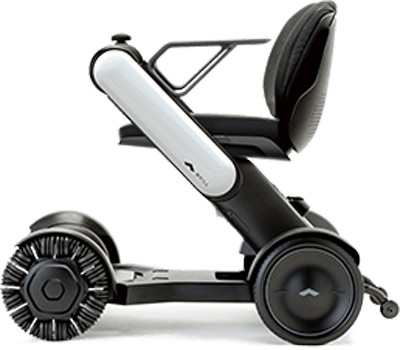
By Gary M. Kaye
Chief Content Officer, Tech50+
(www.tech50plus.com)
According to the website Pants Up Easy, which tracks disabilities, some 3.6 million Americans over the age of 15 use a wheelchair. Perhaps that seems small, but it doesn’t include folks using a cane, crutches or a walker (11.6 million). Overall 20 percent of women in the U.S have disabilities, and 17 percent of men. This disabled population pays a huge price, one which American society largely ignores. Take medical devices such as stairlifts, wheelchairs, ramps, and commodes – some of are covered by either private insurance or Medicare Part B, but many are not. You need a doctor’s prescription and prior authorization, which will only be approved if the item is a medical necessity. Electric powered personal mobility devices like scooters are not approved medical devices.
Some of the most technologically advanced devices come from California based Whill. Their Model A and the Model M – which look nothing like wheelchairs – are FDA approved medical devices and may be eligible for Medicare reimbursement. Each weighs about 250 pounds, and while both are incredibly maneuverable, they are large and don’t take well to tight spaces. I opted for the Whill Model Ci – not an approved medical device – but at 115 pounds it’s less than half the weight of the other models and can be disassembled into three components for relatively easy transport. The Ci is smaller and can handle tight spaces in my home. Even so, after a couple of months the walls and doorways do show some dings, and the wheelchair arms show scuffing from close encounters of the doorway kind.
Pricing varies, with the model Ci going for about $4,000, the Model M about $10,000 and the Model A about $8,000.
Only the beginning
Getting the chair is just the beginning. If you have a home with steps you’ll need ramps inside and outside. Small folding ramps can cost under $100; larger, permanent ramps can run into the thousands. If you truly want to be mobile, you’ll want to take your chair with you. Specially designed wheelchair vans run as high as $100,000 and may require a second person to operate. I opted for an outside lift that fits into a standard hitch receiver. You may also need a larger vehicle; most sedans and station wagons, despite their rated towing capacity, cannot support the downward weight of the lift and chair, known as the tongue weight – of 350 or more pounds. Installing a trailer hitch with wiring harness will cost anywhere from $250 to $500.
I went with an outside lift from Harmar – the Harmar AL 301 HD. Price with installation and an option that allows me to swing the platform aside to load cargo came to about $3,300. You don’t need to spend that much, but any decent lift will probably set you back about $2,000. With the Harmar lift, I drive the chair onto the lift platform, secure it with included tensioners, raise the lift and drive away. When you get to your destination, you lower the lift then just drive off. The platform folds flush against the back of the vehicle when you’re not using it.
Know before you go
Even though the Americans With Disabilities Act (ADA) was signed into law 28 years ago, there are still many places that don’t comply. Whether it’s a concert venue, sporting event, hotel, restaurant, or store, call ahead to find out if they are wheelchair accessible and the location of ramps, automatically opening doors, etc. Even medical offices are not all wheelchair friendly.
Using public transit or city sidewalks can be a problem. For example, do the sidewalks have curb cuts? Many cities provide kneeling buses that lower to take on a wheelchair. However, getting from the platform into a train can be an obstacle. In urban mass transit systems, particularly older ones, you just cannot get that wheelchair from Point A to Point B.
For the disabled, mobility is a major component of their well-being, both to reach medical care at a reasonable price and to prevent social isolation, which studies have found may lead to physical deterioration as well.
This spring I became disabled. It is not clear whether the condition is permanent or temporary. But for now, I wanted the freedoms to go where and when I wanted to go and for the sake of domestic tranquility, to free my wife and daughter from chauffeur and nursemaid duty. I gave up my sports sedan in favor of an SUV that could support wheelchair and lift. Now I can get to doctors appointments on my own. I can go to a supermarket and not worry about whether they've run out of those electric shopping carts.
The price has been staggering. With the new vehicle, wheelchair, ramps, power lift, the total is about $30,000. That’s a pretty penny to get around, and one that, sadly, will make it impossible for many disabled Americans to easily leave home and retain a measure of independence.
Gary Kaye is the creator of Tech50+ (www.tech50plus.com), the leading website covering technology from the Baby Boomer perspective. Kaye has been covering high tech for more than 30 years with outlets including NBC, ABC, CNN and Fox Business. He is a regular contributor to AARP and other websites on issues regarding the nexus of technology, seniors and baby boomers.